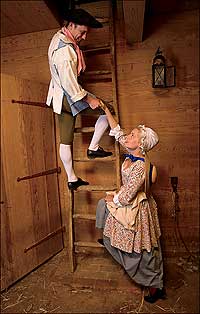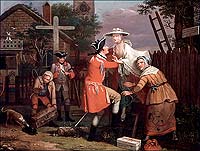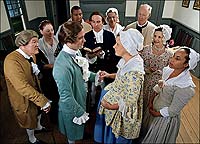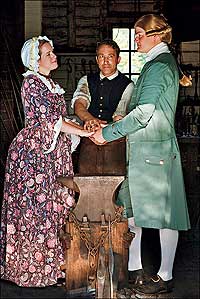Page content
Courtship, Sex, and the Single Colonist
Text by Andrew G. Gardner
Photos by Dave Doody

Giving the slip to censoring eyes, interpreters Richard Gilliland and Megan Brown climb into a hayloft to kindle a mock courtship.

Defying parental prohibitions, youths occasionally caught the quickest ride to their connubial destination. At left, a coach waits for a pair leaving by the back fence in John Collet's The Elopement, from ca. 1764, in Colonial Williamsburg's collections.

Starting a family at times leapfrogged a wedding—baby-to-be making a party of three. Ben and Ellen Knecht exchange vows—with, from left, John Labanish, Pamela Blount, Andre Lane, Mike Luzzi, Teresa Ponziani, Jim Kent, Pat Mahon, and Christina Lane.
Many a modern mother and father brood about the matches their sons and daughters will make. Whom will the kids bring home to meet them? Will there be tattoos? Nose rings? The anxiety is quickened by the feeling that society has been on the road to ruin since maybe Miles Standish's day and that the prospects of their offspring walking the path to the altar with a nice young man or sweet young woman have greatly diminished since John Alden and Priscilla Mullins made the trip. Not a few parents pine for the courtship rules and rites of, let us say, those halcyon colonial times, when, as they understand it, propriety tempered ardor, virtue checked passion, and abstinence made the heart grow fonder.
"Distance," as Thomas Campbell wrote in 1799, "lends enchantment," and two centuries later, for many worry-ridden parents, the perfect courtship model follows in the footsteps of Jane Austen's smoldering Mr. Darcy and the demure Miss Elizabeth Bennett, where ne'er a lusty thought or word between them passed. But the rituals of Austen's Pride and Prejudice—idealistically drafted in 1796—as shining examples have long since been passed over, and courtship, that delicate art of hooking a prospective mate and playing the fish all the way to a preacher, is all but dead. Leon Kass of the University of Chicago says that nowadays "for the great majority, the way to the altar is uncharted territory: It's every couple on its own bottom, without a compass, often without a goal. Those who reach the altar seem to have stumbled on it by accident."
It may be that the traditional route to conjugal correctness—chaste courtship, formal engagement, church wedding, consummation, and parenthood, in that order—is less traveled. But historians say the modern, mixed-up, anything-goes form of bonding that includes physical intimacy and permanent or temporary cohabitation, with children born in or out of wedlock, is not altogether different from some of the practices of segments of seventeenth- and eighteenth-century populations.
As far as chaste courtship is concerned, the good old days have been overrated, almost as mythical as the Standish-Mullins-Alden triangle that Longfellow invented. Blame human nature if you like, but for want of a better phrase, hanky-panky was as prevalent among some eighteenth-century folks as it is among some of the twenty-first's. Beyond doubt, most people stayed strictly within the bounds of propriety, but in the mid to late 1700s, more than one girl in three was pregnant when she walked down the aisle. In parts of Britain, 50 percent of brides were great with child.
Court records are a trove of intimate tittle-tattle and gory details that shamefaced ladies and gentlemen would have preferred to keep private. Lawsuits transcend social class, and the documents of the disputes leave the impression that all the way up to the lesser gentry, there was dirty linen.
For upper-class English and Americans, keeping up appearances was paramount, and heaven forbid that a daughter should tie the knot with, in the vernacular, a bun in the oven. The family would be mortified. Of enormous concern to quality folk was the social standing of a child's potential mate. In Romeo and Juliet tradition, status, property, and wealth were the dealmakers or the dealbreakers.
In early colonial days, marriage might have little to do with the emotional entanglement of two young people. Emotions were fickle and not to be trusted. Romantic love did not figure in the parents' equations, and it was not until about the middle of the eighteenth century, when parental influence began to decline, that the concept of love got serious consideration as a matrimonial prerequisite. Today, love is popularly considered the reason for a marriage, but for the best part of 150 years, colonial marriages among the gentry were arranged in the same way that they are still agreed upon in parts of the world. The higher up the colonial ladder of success and status, the greater was the pressure for the children to marry well. The survival and consolidation of the families' power and prosperity were at stake. Courtship and marriage were arrangements that would be of mutual benefit to the families. Love would have to wait.
There were instances when young women and men tried to circumvent the order of the day. But any red-blooded young male who independently set his cap at a particular young lady and approached the parents with a view to instigating a formal courtship was in for a hard slog. Influential relatives had almost complete control of the course of events. The lad had to sit at the negotiating table with the young woman's parents or guardians and show that financially he had what it took to keep his future wife in the style to which she was accustomed. The wealth that he could bring to the table came from his kinsfolk: the ones who could promise money, land, and support.
The problem was that a swain eager to start a household of his own often had to wait until his father or guardian saw fit to dispense his property in the son's favor. Sometimes a younger son or daughter could not be betrothed before his or her elder siblings. In such situations, couples had to wait into their late twenties before formally entering the connubial state—which some historians say created fertile ground for extracurricular shenanigans, broken promises, and court battles. For the more unfortunate, if the parents disapproved of their son's choice, they could veto the alliance.
The woman's father was expected to provide a dowry. The well-heeled were aware that there were scurrilous and ruthless fortune hunters looking to ensnare wealthy heiresses. Often, negotiations fell apart. For some couples there was heartbreak; for others, resignation. And for a couple determined to buck tradition and marry without the blessing and support of their families, it was a choice between love and money.
For the lower end of the social scale, property was not such a problem. There was not much. That made romance less of an ordeal. Since the Middle Ages, it had been accepted in England that a couple could have a common law—in effect, a do-it-yourself—marriage arrangement, and as immigrants flowed into the New World, they brought the custom along. The arrangement was a spoken marriage contract—in Latin verba de praesenti—taken alone or before witnesses. For couples that could not secure their families' blessings, this was a consolation.
You joined hands and declared that you took each other to be a lawfully wedded spouse, and lived together. Henceforth you were man and wife. This short but sweet ritual went by the name "handfasting" or "spousal." Parental permission did not enter the picture. No priest, minister, magistrate, or license was called for, although it was not unusual for blacksmiths to officiate—the anvil becoming a symbol of where long-lasting unions were forged.
The ceremony could as easily be performed in a field, a garden, an alehouse, or, as was often the case, in a bedroom. What could be easier, or more open to abuse? It's easy to imagine a libidinous youth promising in a few words to have and to hold in order to secure his wicked way with a young country maiden, later to renege on the deal.
Sometimes these affairs ended happily, sometimes not. For young girls, it was prudent to hide a couple of friends in the closet to secretly witness the pledges and forestall backsliding. They could be summoned to give evidence in a breach of promise case if the young suitor was less than honorable and had turned his eye elsewhere. There are in court records countless stories of such skullduggery.

The forging of a strong union could be celebrated at a literal anvil, here blacksmith Steve Mankowski uniting Kara Ernst and Cash Arehart.

Bundling was a practice run at marital compatibility under the family roof, with bundling boards and sacks serving to keep the runners apart. Couples, here Alex Jakubow and Maggie McDonald, didn't always obey the ground rules and jumped their lanes.
For spousals that were genuine and well intentioned, there was often the gift of a bent coin or half a broken silver sixpence to cement the union. The new husband would keep one half, until death did them part—or he did a runner and disappeared.
There was a version of the contract called the spousal de futuro, which was something like a modern engagement—a marriage contract to be consummated at a later date. If, as was often the case, the couple jumped the gun and began living together, and the girl became pregnant, the contract automatically was bumped up to a full-blown marriage, and the couple became man and wife in their neighbors' eyes. To colonial communities, pregnancy made the marriage.
By the middle of the eighteenth century, parental control was on the wane. There was a spike in the illegitimacy rate. The old fire and brimstone Puritans like Phillip Stubbes would have been shaking their heads and assigning blame where they thought it belonged ...on dancing:
Dancing, as it is used (or rather abused) . . . is an introduction to whoredom, a preparative to wantonness ...and all kinds of lewdness. For what smooching and slabbering one of another, what filthy groping and unclean handling is not practiced everywhere in these dancings?
From the top to the bottom of the social scale, dancing featured in colonial courting—as it does today. But there is perhaps another reason for the increased waywardness of the age, the adoption and practice of bundling. If the Puritans thought dancing was bad, bundling must have set their black hats ablaze with fury.
"Bundling" is a word that you will not find in Dr. Spock or any other modern parenting manuals. In the eighteenth century, bundling was roughly equivalent to a night out with a hot date in a Chevy back seat at a mid twentieth-century drive-in, except that the cavorting took place at the girl's home and more often than not was encouraged by the parents. It is a subject that intrigues academics, and their conclusions make for interesting reading.
It's said that the precedent for bundling came from the biblical story of Ruth and Boaz, in which Ruth, a young widow, and Boaz, a wealthy landowner, spend a night together on a threshing room floor and go on to become husband and wife.
Bundling, or bed courting, as it was also known, was introduced to the American colonies by the early flood of Scots, Welsh, and other European immigrants. Doubtless, the cold, damp nights of their northern climes contributed to its popularity. Bundling under the covers panders to a certain Scottish thriftiness toward winter heating bills, as an eighteenth-century ditty confirms:
Since in a bed a man and maid,
May bundle and be chaste,
It does no good to burn out wood,
It is just needless waste.
A bishop congratulated the devil for promoting bundling because it was "the smartest thing he's done since he put the snake in the garden." For today's parents, the idea of bundling takes some adjustment. Mom and Dad may be okay with sleepovers, but bundling adds a dimension.
The idea was that if a couple was seriously courting, it should spend a night together in the girl's bed to ensure compatibility. There were ground rules: underclothes must be kept on at all times, parents would retire to their own bedroom, and there should be no hanky-panky. To that end, the bundling board or the bundling sack might make an appearance. The bundling board was a large plank placed between the two lovers. It has to be said that as a form of contraception it is suspect. The bundling sack was like a double sleeping bag sewn up the middle.
Bundling ensured that when, as happened regularly, the young girl became pregnant, there would be witnesses to hold her suitor to account and to make sure that the marriage knot was tied good and proper. These young adults were not saints. Temptation and opportunity yielded the inevitable result. Marriage by a spousal contract or in the church followed, the community accepted the offspring, and life went on in much the same way as it does today.
Andrew Gardner, who writes on Canada's Salt Spring Island, contributed to the summer 2007 journal an article about veterinary medicine and practices of old.
Suggestions for further reading:
- J. A. Leo LeMay, ed., Robert Bolling Woos Anne Miller:Love and Courtship in Colonial Virginia, 1760 (Charlottesville, VA, 1990).
- G. R. Quaife, Wanton Wenches and Wayward Wives (London, 1979).
- Ellen K. Rothman, Hands and Hearts: A History of Courtship in America (New York, 1984).
- Lawrence Stone, Uncertain Unions and Broken Lives: Marriage and Divorce in England, 1660–1857 (Oxford, 1995).

